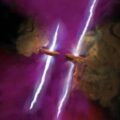Besides being a staple of “College Life” globally, instant noodles in their many varieties are easily one of the most popular and convenient ‘on-the-run’ meals that get turned to when the hunger kicks in. And now they’re on the menu for those in orbit on the International Space Station. Nissin is producing UFO brand Yakisoba noodles for astronauts, with ‘space ramen’ as a tasty instant meal alternative to be eaten alongside the best view of our planet from space.
BACKGROUND: FROM ANCIENT NOODLES TO SPACE ORBIT
Japan ranks as the fifth nation of the highest consumers of instant noodles, and even has August 25 pegged as an annual “Instant Ramen Day.” It’s on that day that it’s encouraged to remember August 25, 1958, as the day that Nissin Foods released the now famous Chicken Ramen, the world’s first instant noodle product that would go on to be a favorite in kitchens, restaurants, cafes, college canteens, and even camping sites, everywhere.
The ‘instant noodles’ meal exploded in popularity and very quickly came with an ever-increasing amount of flavor options. It was cheap to buy, simple to prepare, and was good with practically any flavor variation you could think of. At the time, Japan was growing economically, experiencing a boom in productivity and profitability known as the “high increase economic miracle.” Basically, the cities were swelling with workers coming in from rural areas and in everything from consumer electronics to vehicle sales and exports, Japan was in an explosive phase of economic growth where fast food such as instant noodles would power workers on long shifts with minimum downtime due to eating breaks.


In a relatively short time, competitors to Nissin emerged, and the growth of the instant noodle sector of the international food market has just kept growing, with statistics showing, in 2017, sales in excess of 100 billion servings.
When it comes to ancient origins, the earliest mention of wheat dough-based noodles was found in 2,000-year-old texts in China, from the Eastern Han period. Although 4,000-year-old archeological evidence has been found, also in China, that points to the consumption of starchy noodles.
Here we are in the space age, and now this instant meal has been specially formulated for astronauts so that they’ll soften rapidly for consumption with 158-degree Fahrenheit (70-degree Celsius) water, which is the standard temperature supplied on the International Space Station, as opposed to the 212-degree Fahrenheit water that instant noodles normally require.
HOW-TO: THE ART OF EATING SPACE NOODLES
Japanese engineer and astronaut Soichi Noguchi had a big part to play in the latest testing and development for the Nissin line of astronaut meals, primarily because he had expressed his preference to eat his favorite comfort foods while on his next deployment aboard the ISS. Noguchi first ventured into space on 26 July 2005 for NASA’s first “return to flight” Space Shuttle mission, and on the second day of the mission, Noguchi tried a portion of space noodles, giving him the unique title of being the first noodle-eating man in space.
Noguchi has made several trips into orbit, his latest time with SpaceX Crew 1, where he went on to conduct his fourth career spacewalk with Kathleen Rubins on March 5, 2021, spending almost 7 hours outside the International Space Station.


There are seven varieties for hungry space travelers to choose from, including the original cup noodle flavor, a rice-based Hayashi Meshi variety, a spicy curry flavor, keema curry, chicken ramen, seafood, and the UFO branded Yakisoba which is a favorite all over Asia.
Astronauts have the choice of being able to eat directly out of the containing bag or consume the instant meal with the usual method of sucking it through a tube. The space meal soup base for the instant noodles and instant rice mix is thick enough to prevent it from floating out of the containing bag.
Participation of Japanese citizens in flights aboard the now terminated Space Shuttle NASA missions, and currently aboard SpaceX missions always trends well and gets many popular mentions in the mainstream media as well as online memes and food product commercials. Saitama Prefecture-born astronaut Koichi Wakata is reported to have eaten Soka Senbei which is a kind of hard Japanese rice cracker local to his prefecture, as well as vacuum-packed curry, and instant rice onboard the space shuttle during STS-92.
The Japan Aerospace Exploration Agency (JAXA) even features space noodles products on its website which is now actually commercially available for public consumption via Nissin, specifically Curry Flavor Ramen Noodles and Yakisoba noodles, popular in Japan.
A statement on the JAXA website reads, “Nissin Yakisoba U.F.O. (pan-fried noodles), has been modified for being eaten in space. Yakisoba U.F.O. is characterized by its spicy special sauce. This new version of the product reproduces the flavor of the original with its powdered sauce and is based on a new type of noodle that absorbs all the added hot water. This makes it ideal for preparation in space since disposing of extra water is not feasible in a space environment. The crunchy cabbage and pork add to the tastiness.”
Outlook: Ramen is the perfect Space Food
Freeze-dried and dehydrated foods have been a staple of space missions, both during the Shuttle Program and during missions on the International Space Station. The orbiting laboratory doesn’t have refrigerators or freezers to keep food fresh so instant space noodles clearly have a delicious future aboard the ISS and any planned long-term missions to the Moon and Mars.
Follow and connect with author Cristina Gomez on Twitter: @Eyes_OnTheSkies
